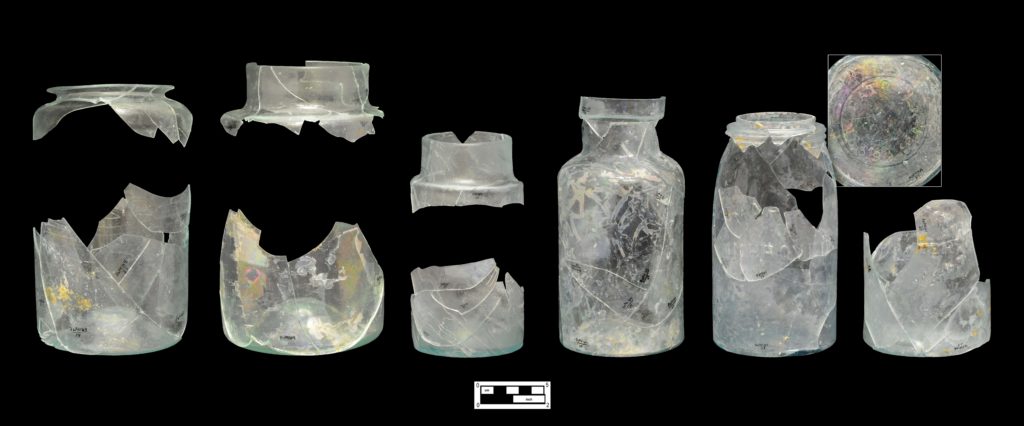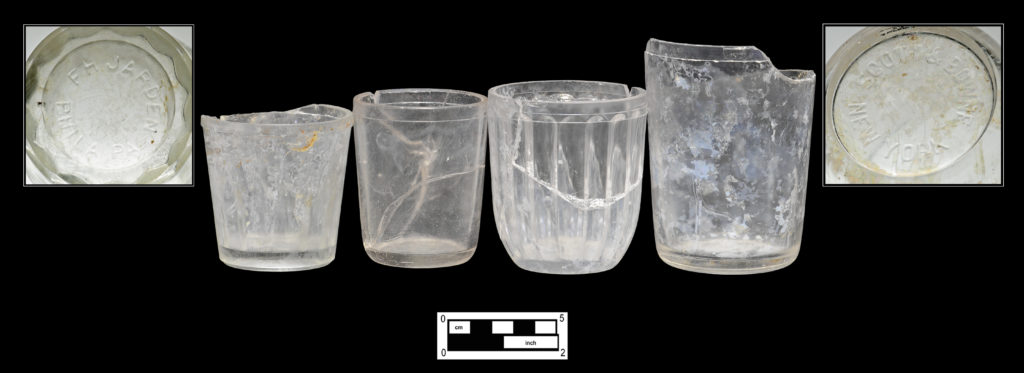Prior to advances in refrigeration and freezing of fruits and vegetables, the summer abundance was preserved through various methods in different types of containers. Several glass vessels recovered from this feature show the types of containers available and offer a look at some of the improvements in food storage by the end of the nineteenth century.

Pickling and Preserving Jars
Several partially reconstructed glass containers represent an early type of jar used for food storage. Among the jar fragments, there are two different configurations of rims; several examples have a vertical rim (4A-G-0312 and Cat # 4.39.7), while at least two jars were finished with everted rims that curve outward (Cat # 4.24.335 and 4.24.336). These tall cylindrical jars are similar in form to ceramic storage containers made of red earthenware or stoneware and used for preserving and pickling. In the 1805 American edition of The Art of Cookery Made Plain and Simple, Hannah Glasse advised readers to use glass vessels for pickling: “These not only last longer, but keep the pickle better: for vinegar and salt will penetrate through all earthen vessels; stone and glass are the only things to keep pickles in.” 1 Another obvious advantage of using glass instead of ceramic was the ability to visually inspect the contents without having to open a container.
These early jars were most likely made at one of the local glassworks. The body fragments are extremely thin and other irregularities in the glass would have made it difficult to transport them from any distance without breakage. Among the glass containers Dr. Thomas W. Dyott advertised in 1824 were “pickling and preserving jars” in sizes from a half pint to one gallon. Dyott offered these jars with “strait and turned over tops.” 2 The 1847 price list for Burgin and Pearsall at the Philadelphia Glass Works offered specie jars from half pint to two gallons, pickle jars in four sizes (from pint to one gallon), and preserve jars ranging from half pints to half gallons. 3 The Philadelphia Glass Works was located a few blocks away at 525 Girard Avenue and stretched across the block from Palmer to Montgomery Streets.
While no evidence of the lids was found, the straight collar variety could be covered with a tin lid or a large cork, tarred to make the container airtight. Jars with the slightly everted rims and a short constricted neck were probably covered with treated paper, leather, cloth, or a bladder tied tightly around the neck.
Glass catalogs from the third quarter of the nineteenth century and later show that this cylindrical form with a simple lip continued to be manufactured as “specie,” “squat,” or “tall” jars after the introduction of glass canning jars with improved methods of sealing. 4
Canning Jars
Portions of three “fruit” or canning jars from this shaft feature mended sufficiently to reveal some identifiable characteristics. One nearly complete canning jar features a defined shoulder with a narrow, straight neck and slightly wider straight collar rim (4A-G-0322). Although there was no evidence of an embossed mark on this jar, it appears similar to the patent diagram for an all-glass stopper granted to A. R. Kline of Philadelphia on October 27, 1863. 5 Kline’s patent information was embossed into the glass stoppers and a search of recent auctions revealed that none of the Kline-stoppered jars offered in recent transactions contain embossed marks.
Another jar is embossed on the body with “Mason’s Improved” and the base is marked “Patd Jan 19 1869” (4A-G-0323). This information refers to John L. Mason’s Patent #86,089 for the top seal, screw cap Mason jar. Mason’s original jar design sealed on the shoulder; this improved patent employed a glass lid sealed at the lip by means of two gasket packing rings and secured in place with a “metallic screw ring.” 6
The center of the base of this jar is marked “5.3.” Such numbers on the base of canning jars are sometimes mistaken for mold or model numbers. Prior to machine-made glass, a team of workers made each jar to speed up the production process. Members of the team were paid based on the number of jars they produced in a day. The numbers embossed on the base identified which team made a particular batch of jars.
The body and base of a third canning jar display embossed marks that aided in identification (4A-G-0319). The front of the jar is embellished with a wreath-like ring of embossed fruits and vegetables around the last three letters of the name “DEXTER.” Early researchers had connected this jar with those marked “Franklin” and “Franklin Dexter,” and tentatively linked them to Gillinder’s Franklin Flint Glass Works. 7 More recent research suggests that the Whitney Glass Works in New Jersey made Dexter jars with the embossed fruit pattern from 1884 through the late 1880s. 8

Jelly Tumblers and Commercial Containers
Another method of processing an abundance of fresh fruit for later use was to put it up as jellies, jams, and preserves. Three nearly complete examples of jelly tumblers or glasses were identified from this feature. These pressed glass containers were used to hold either homemade or commercially prepared jellies, jams, or preserves. The surviving catalogs for the McKee Glass Company of Pittsburgh, Pennsylvania, show a fluted jelly tumbler offered for sale between 1859 and 1871. The illustrations show flutes extending the length of the container, except for the small beveled area at the rim, designed to secure a cover. 9 Atterbury and Company, also of Pittsburgh, held a patent for jelly glasses as early as October 27, 1868. 10
One of the jellies is plain; the others have pressed vertical ribs or miters molded around the interiors (4A-G-135, 4A-G-019, 4A-G-133). These vessels usually sealed by means of a metal cap and were used for making and storing homemade jellies and preserves. Many of the later jelly cups manufactured for commercial use were made without threading or a projecting ledge at the rim, allowing them to be reused as drinking vessels. 11 The 1897 Sears and Roebuck catalog offered both prepared “jellies in tumblers” and cases of empty “jelly tumblers” for making home preserves. 12
One of the jelly tumblers carries embossed information on the base: “F.H. Jarden Phila PA”(4A-G-019). Between 1878 and 1887, Frank H. Jarden’s business was listed in association with extracts, preserves, fruit butter or jellies. His business address during that time was listed as either 104 or 106 Callowhill Street. This jar most likely contained one of the fruit products Jarden prepared.
A slightly larger commercial container closely resembles the plain jelly tumbler (4A-G-352). This vessel is embossed “Scott & Bowne New York” in a ring on the base. The partners were known for “Scott’s Emulsion,” a cod liver oil preparation that was advertised extensively as a cure for consumption and wasting diseases. A brief biography of Alfred B. Scott states: “In 1873 he, in association with his cousin, Samuel W. Bowne, began experimenting with cod liver oil, with the view of rendering this highly valuable medicine palatable and easily digestible.” 13 By 1876, they established their business in New York City and began the manufacture of Scott’s Emulsion. Their product was so successful, they opened branches internationally in Canada, England, Spain, Italy, Mexico, South America, and elsewhere. 14 Surviving trade card advertisements and Internet auction sites suggest that Scott’s Emulsion was commonly packaged in bottles, not in wide-mouthed commercial containers like the one recovered. At present, it is unclear if this commercial tumbler was originally a container for Scott’s Emulsion or offered as a premium with bottles of the product.
References
- Hannah Glasse, The Art of Cookery Made Plain and Easy (Alexandria, VA: Cottom and Stewart 1805 Reprint, edited by Karen Hess; Bedford, MA: Applewood Books, 1997), 161. ↩
- Helen McKearin, Bottles, Flasks and Dr. Dyott (New York, NY: Crown Publishers Inc., 1970), 36. ↩
- George Griffenhagen and Mary Bogard, History of Drug Containers and their Labels (Madison, WI: American Institute of the History of Pharmacy, 1999), 106. ↩
- Pyne Press Editors, Pennsylvania Glassware 1870–1904, (Princeton, NJ: American Catalogue Collection, Pyne Press, 1972), 31; M’Kee and Brothers, M’Kee Victorian Glass Five Complete Glass Catalogs from 1859/60 to 1871 (New York, NY: Dover Publications, 1981), 60, 136; Whitall, Tatum & Company, Whitall, Tatum & Co., 1880: Flint Glassware, Blue Ware, Perfume and Cologne Bottles, Show Bottles and Globes, Green Glassware, Stoppers, Druggists’ Sundries 1880 (Princeton, NJ: American Historical Catalog Collection, Pyne Press, reprint 1971), 32. ↩
- Julian Harrison Toulouse, Fruit Jars: A Collector’s Manual (Nashville, TN: Thomas Nelson Inc., 1969), 421. ↩
- United States Patent Office, J.L. Mason No. 86,089, January 19, 1869, Google Patents, accessed September 2016, https://www.google.com/patents/US86089?dq=86,089+jar&hl=en&sa=X&ei=6-p3Ur_gAaHisASx_4H4Aw&ved=0CDcQ6AEwAA. ↩
- Toulouse, Fruit Jars, 90. ↩
- Bill Lockhart, Jim Sears, and Beau Schriever, “A.R. Samuel, the Philadelphia Jar Maker,” accessed September 2014, https://sha.org/bottle/pdffiles/ARSamuel.pdf. ↩
- M’Kee and Brothers, Victorian Glass Five Complete Glass Catalogs, 55. ↩
- Lowell Innes, Pittsburgh Glass 1797–1891 (Boston, MA: Houghton Mifflin Company, 1976), 361. ↩
- Olive R. Jones and Catherine Sullivan, The Parks Canada Glass Glossary (Ottawa, Canada: National Historic Parks and Sites Branch, Parks Canada, 1985), 143. ↩
- Sears, Roebuck, Sears, Roebuck Catalogue, 1897 Edition (New York, NY: Republished by Chelsea House 1968), 12, 23. ↩
- Charles Morris, ed., Men of the Century (Philadelphia, PA: L.R. Hamersly and Co., 1896), 225, https://books.google.com/books?id=VtY-AAAAYAAJ&pg=PA225&lpg=PA225&dq=%22Alfred+B.+Scott%22&source=bl&ots=_fSswBUkAY&sig=jWhQMIK1iOisdNtACybJdp2r2fc&hl=en&sa=X&ved=0ahUKEwj2v-qkxIrPAhVJ04MKHQ8tAUEQ6AEINzAF#v=onepage&q=%22Alfred%20B.%20Scott%22&f=false ↩
- Morris, Men of the Century, 225. ↩







